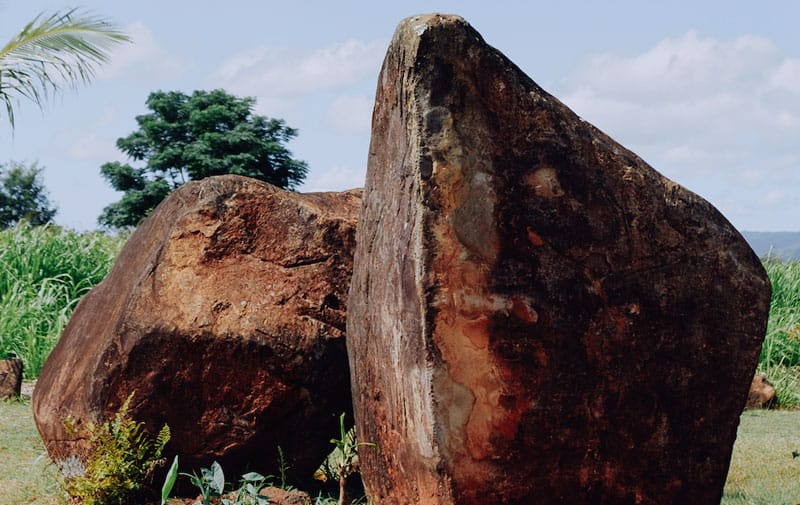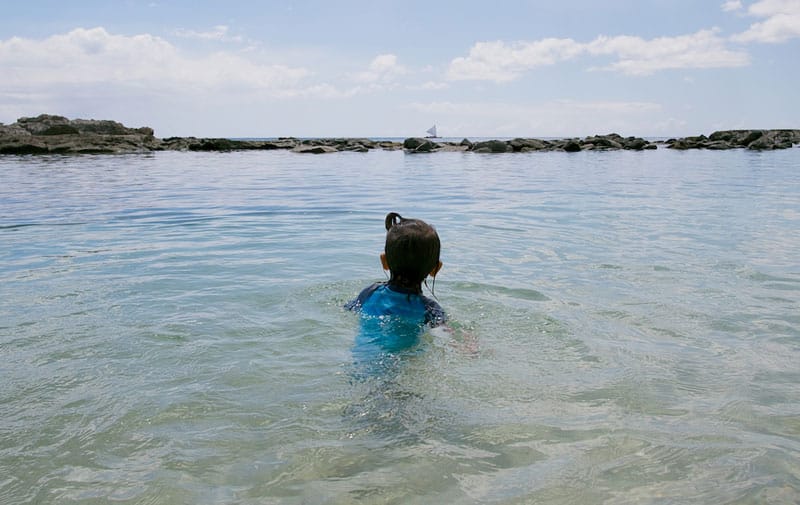A woman connects with mothers past and present in the plains of Kūkaniloko and the waters of Anianikū.
A little baby sat quiet and brave along the shoreline of Anianikū, one of Lanikūhonua’s three lagoons, her petite frame cocooned by folds of warm sand. Her eyes wide, she drank in an intimate scene: The serene waters of the lagoon were gilded gold in the afternoon sunlight, and her parents, flanking her on either side, had their heads bowed. A kahu, or spiritual advisor, was knelt before the small child, deep in prayer. The girl, just shy of 2 years old, was about to receive her pī kai, a sprinkling of saltwater that would purify and protect her. In essence, a blessing.
Oceans of time have passed since the ali‘i, or Hawaiian royalty, regularly journeyed to what is now known as Ko Olina for rest, recovery, and recreation. Travel to this area was dictated by the elemental calendar, in accordance to the moon and stars, and upon arrival, the royal families found respite in the calm, healing waters. They relaxed along the shores, swam in the sheltered lagoons, and feasted on the plentiful white fish found in the coves. When Alice Kamokila Campbell, the daughter of a Native Hawaiian mother and a Scottish industrialist, settled in the area in the 1930s, the mana, or life force, of the place spoke to her. She gifted her new home a name: Lanikūhonua, “where heaven meets Earth.”
The kahu of the area were regularly requested to give blessings here, since those who visited Lanikūhonua often felt a spiritual resonance with its healing waters. Today, such occasions are conducted by Nettie Tiffany—known by most as “Auntie.” The honor of serving as Lanikūhonua’s spiritual advisor was bestowed on her by her mother, Leilani, a kahu and friend to Campbell. Over the years, Auntie Nettie has administered thousands of pī kai—most often for children, like the toddler on the beach— to cleanse them of harmful energies, and offer prayers for a fruitful life.
Only a few years earlier, this baby, Ada, was only a dream of her parents, Ara and AJ. After months of trying to conceive, with no success, Ara had wondered if the universe was refusing her a child due to her wild, unrestrained past. Fear and doubt crept their ways into hushed conversations. She stowed this shame in a small corner of her heart until a friend told her about Kūkaniloko. Located in the cool, windswept plains of neighboring Wahiawā, Kūkaniloko once served as the sacred birthing grounds for aliʻi. For centuries, royal processions traveled to the ancient site in order to give birth to future chiefs and chiefesses. It was believed that the large pōhaku, or rocks, numbering 184 in total, were imbued with the power to lessen labor pains, hence the area’s name, which means, “to withhold the cry from within.”
Over the years, Kūkaniloko has become a place for seekers hoping to connect with mothers past and present. Ara explored this sacred ground in silence, the wind whispering through stands of sweet-scented eucalyptus. She brought with her a hoʻokupu, or gift, an homage to women who had come before her. The small bundle held an assortment of items: a piece of kalo, or taro, for nourishment and fertility; kukui nut oil for its ability to burn clear and long into the night; paʻakai, or salt, for its cleansing properties; lauaʻe fern for its beauty. It also contained Ara’s own prayers and wishes. On a small piece of paper, she drew her hopes: a treehouse overlooking the water, AJ surfing, a baby playing.
This part would need no formal guidance, her friend had explained. Ara’s heart would serve as her spiritual compass. Sitting near an oblong stone, its surface a greenish brown mottled with white lichen, Ara presented her hoʻokupu. Under the wide sky, she thought of Kūkaniloko’s powerful significance in Native Hawaiian culture, the bringing forth of new lives, and of the many women who make pilgrimages here out of reverence. In the background, rising up from the central plains, was the Waiʻanae Range, with its sloping ridges and valleys thought to form the profile of pregnant woman in repose.
Two months later, Ara telephoned her friend with the news: She was pregnant.
Nearly three years later, little Ada, still too young to understand the ceremony, sensed its solemnity and sincerity. Ensconced in the sand—a symbolic connection to the ‘āina, or land—she remained still as the kahu lightly touched her shoulders, her face, and the crown of her head.
When the kahu drew forth a ti leaf and an ‘umeke, or bowl, filled with seawater from the lagoon, Ada watched with curiosity. Chanting softly, the kahu skimmed the ti along the water’s surface. Its swirling eddies proved irresistible, and Ada stretched her hand out to touch. With childish delight, she splashed the holy water with her fingers, and a tiny curl of laughter escaped her lips.
Gazing down, the kahu smiled upon the blessed child.
Image Gallery




